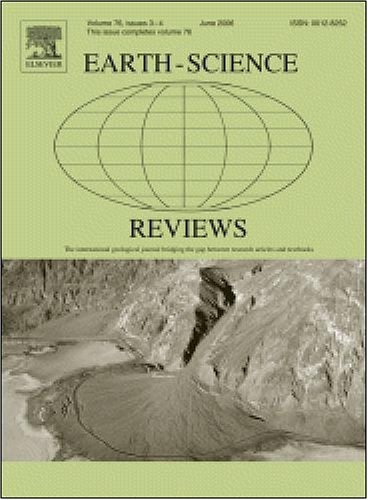Impact of Permian Tarim and Emeishan Large Igneous Provinces on Petroleum Systems and Gas Emissions in Tarim and Sichuan Basins
IF 10.8
1区 地球科学
Q1 GEOSCIENCES, MULTIDISCIPLINARY
引用次数: 0
Abstract
Igneous intrusions and associated hydrothermal activities have significantly influenced petroleum systems and climate conditions at both local and global scale, especially during the Permian period. This review examines the impacts of the Tarim Large Igneous Province (TLIP) and Emeishan Large Igneous Province (ELIP) on the petroleum systems and climate outcomes in the Tarim and Sichuan basins. In the Tarim Basin, the TLIP did not coincide with source rock development, whereas the ELIP in the Sichuan Basin coincided with the formation of organic-rich shales and coals. Thermal effects from igneous intrusions played a critical role in the maturation of source rocks, inducing hydrocarbon generation through the thermal transformation of organic matter. Hydrogen produced from magma or interactions between ultramafic rock and water may play a significant role in hydrocarbon generation within petroliferous basins. Hydrothermal fluids potentially altered mature source rocks in both basins, though the extent remains uncertain. Fractures generated by igneous intrusions not only serve as reservoirs and migration pathways for hydrocarbons, but also enhance reservoir quality through hydrothermal fluid-induced dolomitization in carbonates. Intrusions can also act as barriers, impeding petroleum migration. Trapping mechanisms vary between basins: in the Tarim Basin, folds and faults resulting from intrusion-related deformation are common, while the ELIP's impact on hydrocarbon accumulation in the Sichuan Basin remains less defined. Both TLIP and ELIP released substantial greenhouse gases, yet their climate impacts differ. The ELIP is strongly associated with mass extinctions, whereas the TLIP's environmental consequences were less severe. These differences underscore the need for further research to clarify the influence of igneous intrusions on petroleum systems, source rock maturation, and climate dynamics. Understanding these interactions is crucial for unraveling their roles in geological history and global climate change.
塔里木和峨眉山二叠系大火成岩省对塔里木和四川盆地含油气系统和天然气排放的影响
火成岩侵入及其伴生热液活动在局部和全球范围内对油气系统和气候条件产生了重大影响,尤其是在二叠纪时期。本文探讨了塔里木大火成岩省(TLIP)和峨眉山大火成岩省(ELIP)对塔里木盆地和四川盆地油气系统和气候结果的影响。塔里木盆地的演化演化与烃源岩发育不一致,而四川盆地的演化演化与富有机质页岩和煤的形成一致。火成岩侵入体的热效应在烃源岩成熟过程中起着关键作用,通过有机质热转化诱导生烃。岩浆或超基性岩与水相互作用产生的氢在含油气盆地的生烃过程中起着重要作用。热液流体可能改变了两个盆地的成熟烃源岩,但程度仍不确定。火成岩侵入体形成的裂缝不仅是油气的储集层和运移通道,而且通过热液流体诱导的碳酸盐岩白云化作用提高了储层质量。侵入物也可以作为障碍,阻碍石油的运移。不同盆地间的圈闭机制存在差异:在塔里木盆地,由与侵入相关的变形引起的褶皱和断裂是常见的,而在四川盆地,ELIP对油气成藏的影响尚不明确。lip和ELIP都释放了大量温室气体,但它们对气候的影响不同。ELIP与大规模物种灭绝密切相关,而lip的环境后果则不那么严重。这些差异强调了进一步研究的必要性,以澄清火成岩侵入对石油系统、烃源岩成熟和气候动力学的影响。了解这些相互作用对于揭示它们在地质历史和全球气候变化中的作用至关重要。
本文章由计算机程序翻译,如有差异,请以英文原文为准。
求助全文
约1分钟内获得全文
求助全文
来源期刊

Earth-Science Reviews
地学-地球科学综合
CiteScore
21.70
自引率
5.80%
发文量
294
审稿时长
15.1 weeks
期刊介绍:
Covering a much wider field than the usual specialist journals, Earth Science Reviews publishes review articles dealing with all aspects of Earth Sciences, and is an important vehicle for allowing readers to see their particular interest related to the Earth Sciences as a whole.
 求助内容:
求助内容: 应助结果提醒方式:
应助结果提醒方式:


